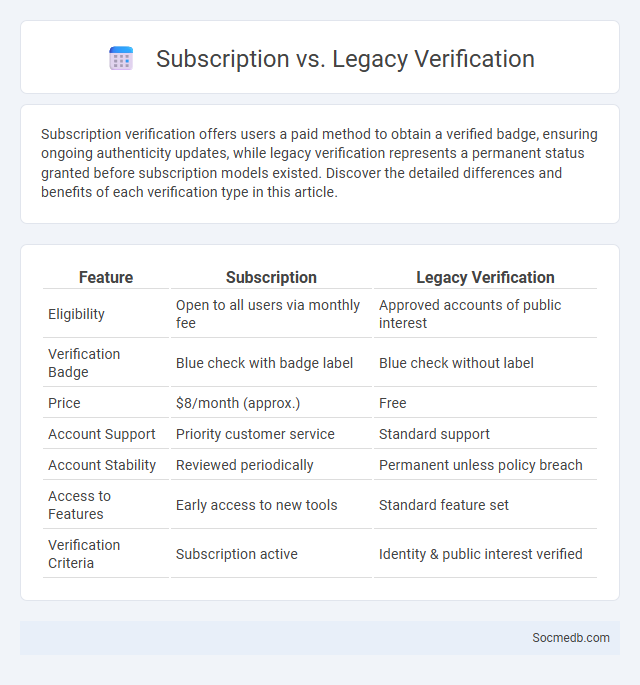
Photo illustration: Subscription vs Legacy Verification
Subscription verification offers users a paid method to obtain a verified badge, ensuring ongoing authenticity updates, while legacy verification represents a permanent status granted before subscription models existed. Discover the detailed differences and benefits of each verification type in this article.
Table of Comparison
| Feature | Subscription | Legacy Verification |
|---|---|---|
| Eligibility | Open to all users via monthly fee | Approved accounts of public interest |
| Verification Badge | Blue check with badge label | Blue check without label |
| Price | $8/month (approx.) | Free |
| Account Support | Priority customer service | Standard support |
| Account Stability | Reviewed periodically | Permanent unless policy breach |
| Access to Features | Early access to new tools | Standard feature set |
| Verification Criteria | Subscription active | Identity & public interest verified |
Understanding Verification Methods: Subscription, Legacy, and Verified Badge
Understanding verification methods on social media is crucial for maintaining your online credibility and security. Subscription-based verification offers a paid option to obtain a verified badge, providing clear account authenticity, while legacy verification is granted to prominent or official accounts before these paid models existed. The verified badge signals trustworthiness and helps users differentiate authentic profiles from impersonators, enhancing your social media presence and trustworthiness.
Key Differences Between Subscription and Legacy Verification
Subscription verification on social media platforms offers real-time badge activation with ongoing updates, whereas legacy verification relies on a one-time, manual review process. Your subscription status ensures continuous authenticity and access to enhanced features like improved visibility and analytics, unlike legacy badges that may lack updated security measures. Subscription verification integrates seamlessly with evolving platform policies, providing dynamic trust signals that legacy verification cannot match.
What is a Verified Badge?
A Verified Badge on social media platforms is a blue checkmark symbol that confirms the authenticity of a public figure, brand, or organization's account. This badge helps users distinguish genuine profiles from impersonators or fake accounts, enhancing trust and credibility when you interact with content. Securing a Verified Badge often involves submitting proof of identity and meeting specific platform criteria related to notability and activity.
Benefits of Subscription Verification
Subscription verification on social media enhances your account credibility by confirming your authenticity, which can significantly increase follower trust and engagement rates. Verified subscriptions often provide early access to exclusive content, ensuring you receive timely updates and premium experiences tailored to your interests. This feature also helps protect your identity against impersonation, safeguarding your online reputation and interactions.
Limitations of Legacy Verification
Legacy verification systems on social media often rely on outdated identity proof methods that lack adaptability to modern fraud techniques. These systems struggle with scalability, leading to delays and inconsistent user verification across platforms. Limited integration with emerging technologies reduces their effectiveness in preventing identity theft and fake profiles.
Criteria for Earning a Verified Badge
Earning a verified badge on social media requires an account to be authentic, notable, and active, representing a real person, brand, or organization. Platforms assess criteria such as completeness of profile information, adherence to community guidelines, and public interest, including media presence or follower count. Verification also demands uniqueness of the account and frequent engagement to prevent impersonation and maintain platform integrity.
Security Implications of Each Verification Type
Social media platforms implement various verification types such as two-factor authentication (2FA), biometric verification, and email or phone verification, each with distinct security implications. Two-factor authentication significantly reduces the risk of unauthorized access by requiring a secondary verification method, while biometric verification enhances security through unique physiological traits but may raise privacy concerns. Your choice of verification method directly impacts the protection of your personal information and the resilience of your social media accounts against hacking attempts.
Impact on User Trust and Platform Credibility
User trust is heavily influenced by transparency in content moderation policies and the handling of personal data on social media platforms. Platforms that actively combat misinformation and enforce consistent community guidelines tend to enhance their credibility and foster a more engaged user base. Your confidence in these platforms grows when clear communication exists about data privacy, content authenticity, and accountability measures.
Choosing the Right Verification for Your Needs
Selecting the right social media verification depends on your platform goals and audience trust requirements. Blue checkmarks on platforms like Twitter and Instagram indicate authenticity and enhance credibility, while business verifications on LinkedIn boost professional reputation. Tailoring your verification choice to your brand's identity and engagement strategy ensures maximum impact and user confidence.
Future Trends in Digital Verification Systems
Digital verification systems in social media are evolving with advancements in AI-powered identity authentication, biometric verification, and decentralized ledger technology, enhancing security and user trust. Your digital identity will increasingly rely on multi-factor authentication methods that combine facial recognition, behavioral biometrics, and blockchain verification to reduce fraud and improve transparency. These future trends aim to create safer online environments by ensuring that social media users verify their identities seamlessly and securely.
 socmedb.com
socmedb.com